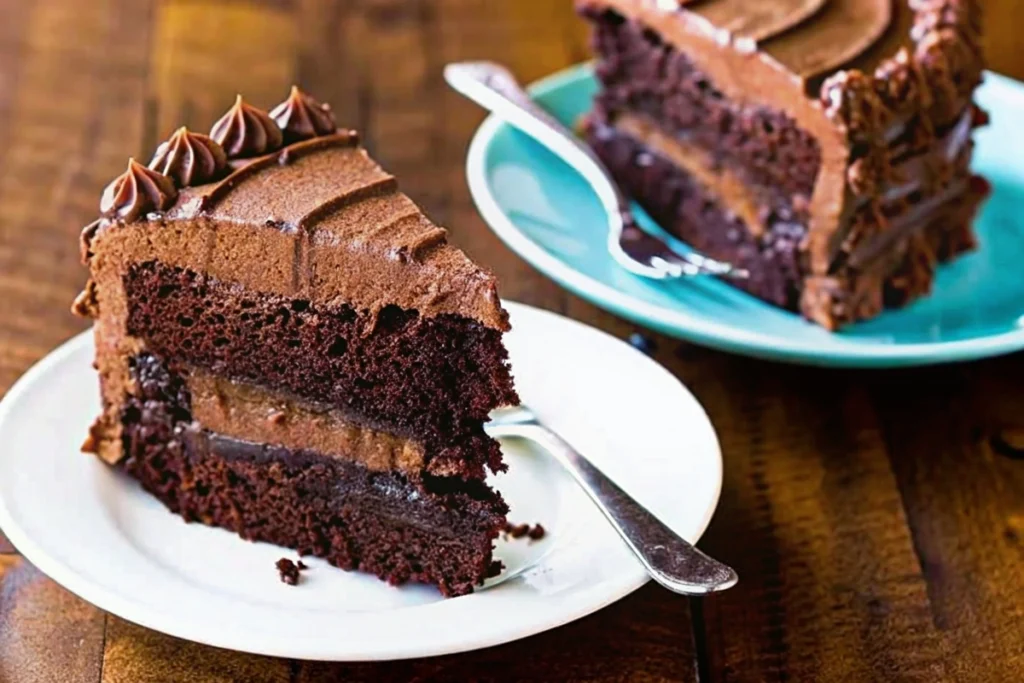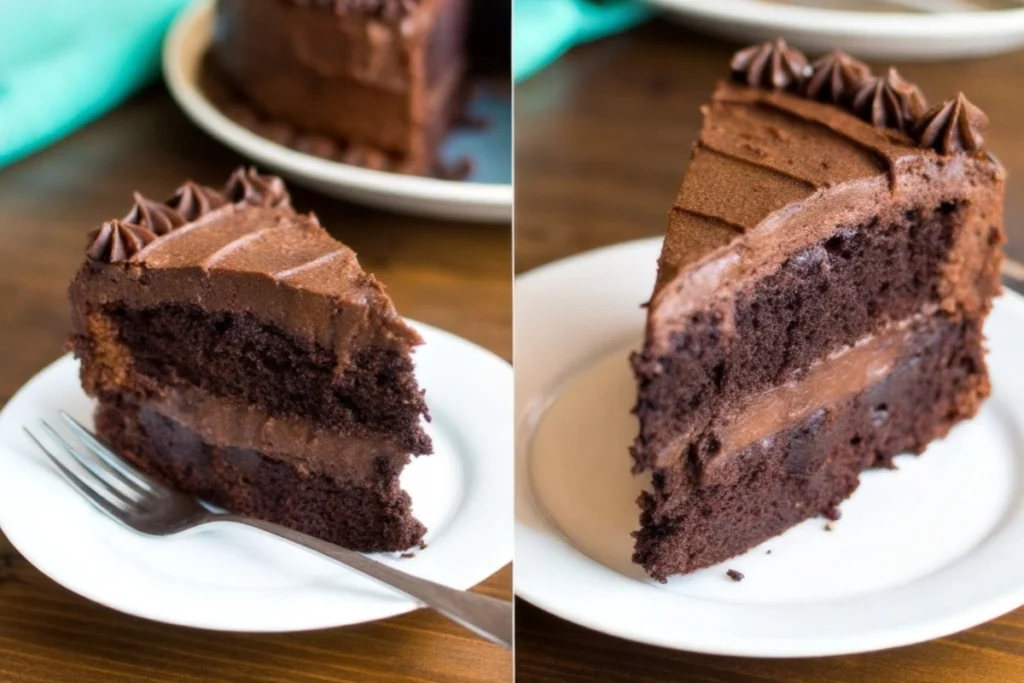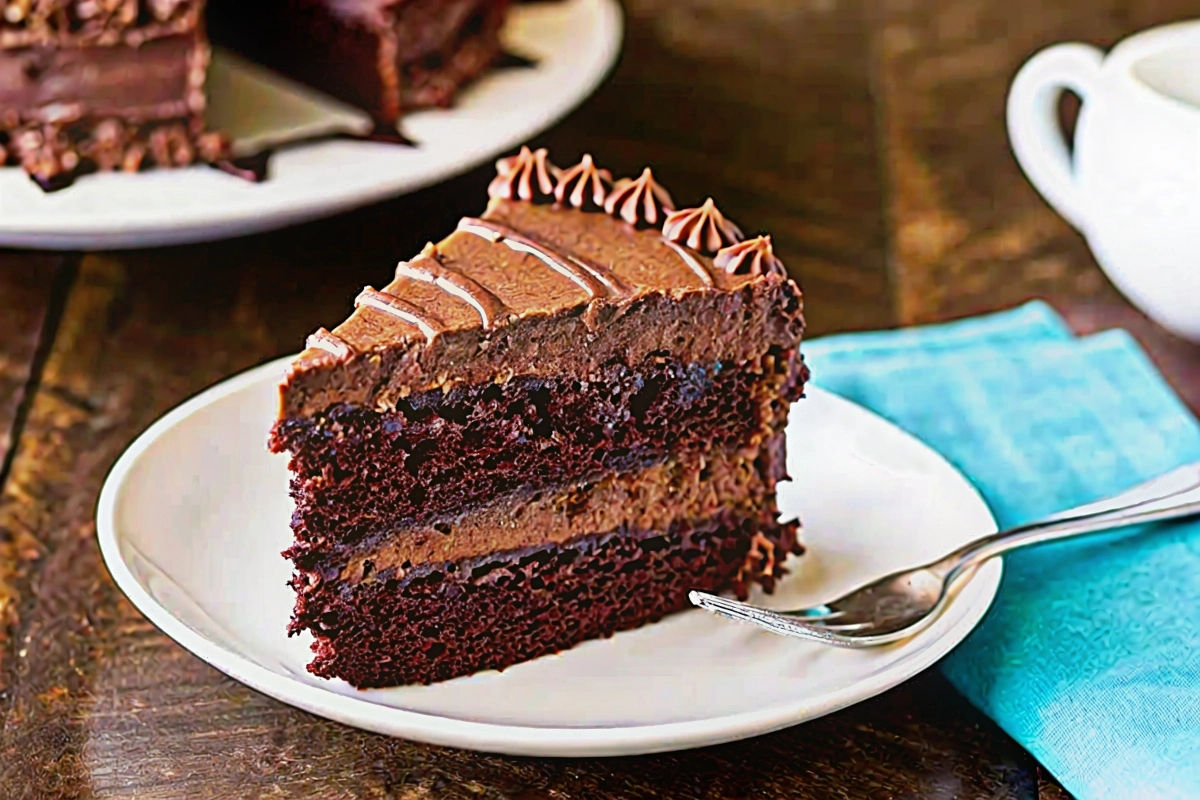Creating the ultimate moist chocolate cake recipe that melts in your mouth is an art form that combines careful technique with quality ingredients. In this comprehensive guide, we will walk you through every step, from the fascinating origins of chocolate cakes to the meticulous process of baking your perfect cake. With detailed bullet-point instructions, tips for variations, and answers to common questions, this article ensures you have all you need to bake a stunning cake that will impress your friends and family.
Introduction
Baking a moist chocolate cake recipe isn’t just about following a recipe; it’s a journey that blends tradition with modern baking insights. This guide is designed to help you master the art of creating a chocolate cake that remains incredibly soft, tender, and richly flavorful from the first bite to the last. Whether you are a beginner in the kitchen or an experienced baker looking to perfect your craft, you will find useful tips and detailed instructions throughout this article.
- What to Expect in This Guide:
- A brief history of the chocolate cake and its evolution over time.
- An explanation of the science behind what makes a cake moist.
- A detailed breakdown of the ingredients that bring this cake to life.
- Step-by-step instructions on how to create your very own moist masterpiece.
- Creative variations to tailor the cake to your taste.
- A section addressing common questions that might arise during your baking journey.
By the end of this article, you’ll be well-equipped with the knowledge to bake a delectable, moist chocolate cake recipe that stands out for its texture and flavor. For additional context on the history and evolution of chocolate, check out Chocolate Lava Cake for an in-depth exploration. In the next section, we’ll delve into where it all began.
The History & Evolution of Chocolate Cake
Chocolate cake has captivated dessert lovers for generations, and its evolution is a testament to culinary innovation. The journey of this dessert mirrors the development of modern baking techniques, making it a fascinating study of flavor and technique.
- Ancient Beginnings:
- Early civilizations first discovered the allure of cocoa, incorporating it into ceremonial drinks and rudimentary sweets.
- Over time, as techniques improved, the idea of baking a cake with cocoa transformed from a rare luxury to a widely cherished treat.
- Modern Innovations:
- The advent of precision baking has allowed chefs and home bakers to experiment with texture and flavor. Techniques such as sifting dry ingredients, carefully folding in wet ingredients, and ensuring the cake is baked at an optimal temperature have revolutionized the dessert.
- Modern recipes have evolved to include moist chocolate cake recipe variations that cater to different tastes, from the classic rich and fudgy style to innovative twists like adding espresso or a hint of spice.
- Cultural Significance:
- Today, chocolate cake is not just a dessert; it’s a symbol of celebration. Birthdays, anniversaries, and special occasions are often marked by the appearance of this luxurious cake.
- Its versatility in presentation, from layered cakes to cupcakes, has cemented its status as a staple in kitchens around the world.
This rich history not only adds depth to our understanding of the best chocolate cake recipe but also serves as a source of inspiration for those eager to explore baking as an art form.
Essential Ingredients & Their Roles
The magic behind the moist chocolate cake lies in the quality and balance of its ingredients. Each component is carefully selected to contribute to a cake that is both rich in flavor and irresistibly moist.
- Chocolate:
- Cocoa Powder: Choose a high-quality cocoa powder for a deep, robust chocolate flavor.
- Melted Chocolate: Alternatively, using melted chocolate can add an extra layer of richness and moisture.
- Fats:
- Butter: Provides flavor and structure.
- Oil: Keeps the cake tender and moist, contributing to a softer crumb.
- Eggs:
- Serve as a binding agent that holds the cake together while also introducing air into the batter, essential for achieving a light texture.
- Leaveners:
- Baking Soda & Baking Powder: These ingredients help the cake rise, ensuring a light and airy texture.
- Salt: Enhances the overall flavor without overpowering the chocolate.
- Flavor Enhancers:
- Vanilla Extract: A small amount of vanilla extract intensifies the chocolate flavor.
- Coffee: Adding a hint of coffee can enhance the chocolate depth without making the cake taste like coffee.
- Liquid Components:
- Milk or Buttermilk: These add moisture and help activate the leaveners, ensuring the cake rises properly.
Quick Reference: Why Each Ingredient Matters
- Butter & Oil: For moisture and tenderness.
- Eggs: For structure and lightness.
- Cocoa & Chocolate: For flavor depth and richness.
- Baking Soda/Powder: For the perfect rise.
- Vanilla & Coffee: For flavor enhancement.

Each of these ingredients plays a specific role in achieving a moist, decadent chocolate cake. Their careful combination and proportion are key to creating a cake that stands out.
Equipment & Preparation Tips
Before you begin baking, ensure you have all the necessary tools and preparation tips to guarantee success. Proper equipment and a well-organized workspace can make all the difference in your baking experience.
- Essential Equipment:
- Mixing Bowls: A variety of sizes for different mixing needs.
- Spatulas & Whisks: To combine ingredients without overmixing.
- Cake Pans: Choose the right size and type (metal or glass) for even baking.
- Measuring Cups & Spoons: Accurate measurements are crucial for the perfect balance of ingredients.
- Preparation Tips:
- Preheat Your Oven: Always preheat your oven to the required temperature to ensure even baking.
- Grease and Line Cake Pans: Use butter or oil to grease the pans, then line them with parchment paper for easy removal.
- Sift Dry Ingredients: Sifting helps to eliminate lumps and ensures a uniform distribution of ingredients.
- Room Temperature Ingredients: Allow eggs, butter, and milk to reach room temperature. This helps them blend more evenly and results in a smoother batter.
- Organize Your Workspace:
- Create a dedicated baking station free from distractions.
- Lay out all ingredients and equipment before starting.
- Follow the recipe steps in sequence for a seamless process.
By ensuring you have the right equipment and following these simple preparation tips, you set the stage for baking the moist chocolate cake of your dreams.
Step-by-Step Recipe for the Best Moist Chocolate Cake
Now that we’ve covered the background and the importance of ingredients, it’s time to get into the heart of the article—the detailed, step-by-step recipe. This comprehensive guide will ensure you produce a moist chocolate cake that’s both delicious and visually appealing.
Ingredients List
- Dry Ingredients:
- 1¾ cups all-purpose flour
- ¾ cup unsweetened cocoa powder (high-quality cocoa powder)
- 2 cups granulated sugar
- 1½ teaspoons baking powder
- 1½ teaspoons baking soda
- 1 teaspoon salt
- Wet Ingredients:
- 2 large eggs (preferably at room temperature)
- 1 cup whole milk (or substitute with a milk alternative for a unique twist)
- ½ cup vegetable oil (for extra moisture)
- 2 teaspoons vanilla extract (for flavor enhancement)
- 1 cup boiling water (this step intensifies the cocoa flavor)
Step-by-Step Instructions
- Preheat and Prepare:
- Preheat your oven to 350°F (175°C).
- Grease and line two 9-inch cake pans with parchment paper to prevent sticking.
- Ensure your oven rack is centered to allow even baking.
- Mixing Dry Ingredients:
- In a large mixing bowl, sift together the flour, cocoa powder, baking powder, baking soda, and salt.
- Whisk the ingredients to ensure even distribution and eliminate lumps.
- Tip: Sifting also aerates the flour, contributing to a lighter cake texture.
- Combining Wet Ingredients:
- In another bowl, beat the eggs until they are light and frothy.
- Add milk, vegetable oil, and vanilla extract.
- Mix until the ingredients are well combined, but do not overbeat.
- Tip: Room temperature ingredients blend more smoothly, preventing any unwanted clumps.
- Merging the Mixtures:
- Slowly pour the wet ingredients into the dry mixture.
- Use a spatula to gently fold the ingredients together. Be cautious not to overmix, as this can cause the cake to become dense.
- Gradually incorporate the boiling water into the batter. The water will thin the batter slightly, but it is essential for achieving a moist and tender crumb.
- Bullet Point Recap:
- Preheat the oven and prepare pans
- Sift and whisk dry ingredients
- Beat eggs and mix wet ingredients
- Fold in wet ingredients and boiling water
- Baking the Cake:
- Divide the batter evenly between the prepared cake pans.
- Place the pans in the preheated oven.
- Bake for approximately 30-35 minutes. Check for doneness by inserting a toothpick into the center of the cakes—if it comes out clean, the cakes are done.
- Tip: Ovens may vary slightly, so start checking at the 30-minute mark.
- Cooling and Demolding:
- Once baked, remove the cakes from the oven and allow them to cool in the pans for 10 minutes.
- Carefully transfer the cakes to a wire rack to cool completely before frosting or serving.

Following these detailed steps will ensure that your moist chocolate cake emerges from the oven with a perfectly soft crumb and an irresistible aroma.
Variations and Customizations
One of the most exciting aspects of baking is the opportunity to customize and experiment with your recipes. The best chocolate cake recipe is versatile, allowing for a myriad of variations that can suit any occasion or personal taste.
Creative Variations
- Gluten-Free Twist:
- Substitute all-purpose flour with a gluten-free flour blend.
- Maintain the ratios and be sure to sift the alternative flour to ensure a light texture.
- Double Chocolate Delight:
- Add an extra ½ cup of melted chocolate to the batter.
- Consider sprinkling chocolate chips between the layers or on top of the frosting for added texture.
- Coffee-Infused Cake:
- Replace part of the boiling water with a strong brewed coffee.
- This enhances the chocolate flavor and gives the cake a subtle, sophisticated twist.
Customization Tips
- Frosting Options:
- Ganache: A rich, glossy chocolate ganache pairs beautifully with a moist cake.
- Buttercream: For those who prefer a creamier topping, a smooth buttercream is an excellent choice.
- Cream Cheese Frosting: For a tangy contrast, opt for cream cheese frosting. (Ensure you’re using ingredients that best suit your taste.)
- Add-ins:
- Nuts: Chopped walnuts or pecans can add a delightful crunch.
- Fruit: Fresh berries or a drizzle of fruit coulis can brighten up the flavor profile.
- Spices: A pinch of cinnamon or chili powder can introduce an unexpected but pleasant kick.
- Presentation Variations:
- Layered Cake: Assemble multiple layers with frosting in between for a show-stopping dessert.
- Cupcakes: Adapt the recipe for individual servings by dividing the batter among cupcake molds.
- Bundt Cake: Pour the batter into a bundt pan for a unique presentation that offers a lovely, intricate design when unmolded.

With these variations, you have the creative freedom to make your moist chocolate cake truly your own, adding personal touches that cater to your taste preferences and special occasions.
Understanding the Moist Factor in Chocolate Cake
What sets a moist chocolate cake apart from a standard one is the precise balance of ingredients and baking techniques. Moisture in a cake is not a mere accident; it’s the result of careful planning and understanding of the baking process.
- Key Ingredients:
- Butter and Oil: These fats play a crucial role in retaining moisture. While butter adds a rich flavor, oil contributes to a tender crumb.
- Eggs: They bind the ingredients together, creating structure while trapping air to enhance moisture.
- Cocoa Powder vs. Melted Chocolate: Using high-quality cocoa powder or incorporating melted chocolate can significantly influence the cake’s texture and richness.
- Baking Techniques:
- Mixing: Overmixing can develop too much gluten, leading to a dense cake. The right balance ensures a light and airy texture.
- Temperature Control: Baking at the correct temperature allows the cake to rise properly without drying out.
- Timing: Knowing when to take the cake out of the oven is critical—too long, and the cake loses its moisture; too short, and it may remain undercooked.
A well-balanced approach to these ingredients
Frequently Asked Questions (FAQs)
Below are some of the most common questions that bakers have when attempting to create the moist chocolate cake of their dreams:
- What makes this chocolate cake recipe so moist?
The secret lies in the careful balance of ingredients, particularly the use of both butter and oil, combined with the addition of boiling water, which intensifies the cocoa flavor and enhances moisture. - Can I substitute ingredients for a different version of the recipe?
Absolutely. You can experiment with alternatives like gluten-free flour or even try a coffee-infused version. The key is to maintain the correct ratios to preserve the cake’s moist texture. - How do I store my moist chocolate cake to keep it fresh?
After cooling completely, store the cake in an airtight container at room temperature. If you have leftover cake, you can also refrigerate it and allow it to come to room temperature before serving. - What are the common mistakes to avoid when baking this cake?
- Overmixing the batter can lead to a dense texture.
- Baking for too long can dry out the cake.
- Not preheating the oven properly affects the cake’s rise.
- How do I know when the cake is perfectly baked?
Use a toothpick or cake tester in the center of the cake. It should come out clean or with a few moist crumbs when the cake is ready. - Can this recipe be adapted for cupcakes or a layered cake?
Yes. The batter is versatile enough to be portioned into cupcake molds or layered between multiple cake rounds. Adjust the baking time accordingly if you opt for cupcakes.
These FAQs cover essential insights that can help you troubleshoot and perfect your baking process, ensuring a consistently delightful chocolate cake every time.
Final Thoughts
In conclusion, this guide to the best moist chocolate cake recipe is more than just a recipe—it’s an invitation to explore the art of baking. By understanding the history, mastering the science of moisture, and following our detailed, step-by-step instructions, you are well on your way to creating a dessert that will impress family, friends, and guests alike.
- Recap of Key Points:
- The importance of high-quality ingredients and precise techniques.
- Detailed instructions to ensure a flawless, moist texture.
- Creative variations to tailor the recipe to your taste.
- Call to Action:
- Try the recipe for yourself and share your results.
- Experiment with the customizations provided.
- Explore other recipes and baking tips for further inspiration.
This recipe stands as a testament to the joys of baking, merging tradition with innovation to produce a truly remarkable dessert.
Tips for Achieving the Perfect Moist Chocolate Cake
To further enhance your baking journey, here are some practical tips and bullet points to remember:
- Preparation is Key:
- Always measure ingredients accurately.
- Preheat your oven before mixing any ingredients.
- Use room temperature ingredients to ensure even mixing.
- During Mixing:
- Fold ingredients gently to avoid deflating the batter.
- Use a spatula for a careful blend of wet and dry components.
- Avoid overmixing to maintain a tender crumb.
- Baking Process:
- Check your cake early to prevent overbaking.
- Use a toothpick to test for doneness.
- Let the cake cool in the pan briefly before transferring to a cooling rack.
- Customization:
- Experiment with add-ins like nuts or chocolate chips.
- Try different frosting styles, from a rich ganache to a smooth buttercream.
- Adapt the recipe for cupcakes or layered cakes by adjusting baking times accordingly.
Conclusion
Baking the best moist chocolate cake is an art that combines tradition with modern techniques. This comprehensive guide has walked you through the fascinating history, the science of moisture, the importance of ingredient quality, and the detailed steps required to achieve a perfectly moist and irresistible dessert.
- Embrace the Process:
Baking is as much about the journey as it is about the result. Each step—from preparing your ingredients to the final decoration—adds to the overall experience. - Share the Joy:
Once you’ve mastered the recipe, consider sharing your creation with family and friends. There’s nothing quite like the satisfaction of serving a cake that not only tastes amazing but also represents your dedication to the craft. - Keep Experimenting:
Use the variations and tips provided to create your signature twist on this moist chocolate cake. Whether it’s a double-chocolate version or an innovative take with a hint of coffee, the possibilities are endless.
By following this guide, you’re well-equipped to produce a decadent chocolate dessert that will impress any guest and stand as a testament to your baking prowess. Enjoy the process, savor the flavors, and let your creativity shine with every slice of cake you create.


1 thought on “7 Steps to the Best Moist Chocolate Cake Recipe: A Complete Guide”